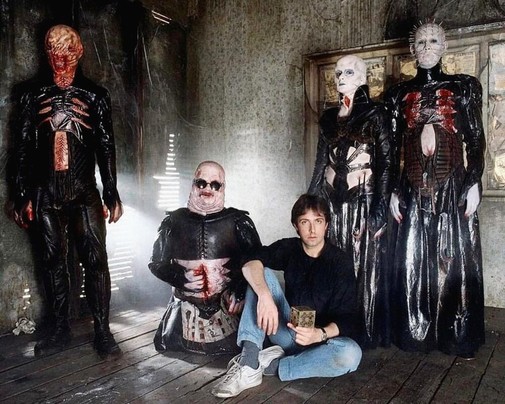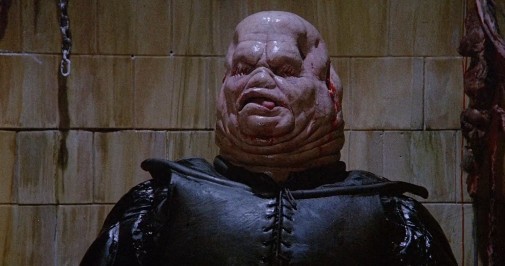Horror Costuming: Hellraiser (1987)
 Monday, October 11, 2021 at 3:00PM
Monday, October 11, 2021 at 3:00PM Last October, I had a lot of fun exploring the art of costume design in horror movies. This Halloween season, the miniseries is back with new misadventures through the annals of horror history and some of its boldest sartorial visions. To get some semblance of order, the write-ups will start with an iconic nightmare of 1980s cinema and move, decade by decade, until a grand finale in the form of an Oscar FYC for the current awards season. So let's start things off by looking towards the meeting point of pleasure and pain, seeking where they become indivisible, and contemplating how such ideas can be materialized in costumes. Clive Barker's Hellraiser has such sights to show us…
One of the most influential horror writers of the 20th century, Barker was unsatisfied with what Hollywood had made out of his work and decided to take his chances behind the cameras. Giving visual expression to the prose wasn't something new for the author. By the mid-1980s, he had revealed himself a multimedia artist, capable of illustrating the stories he penned and even writing their big-screen adaptations. However, neither Underworld nor Rawhead Rex pleased his sensibilities. Boiling over with creative frustrations, Barker decided to helm the subsequent movie adaptation of his disquieting imaginings – Hellraiser, based upon The Hellbound Heart novella.
Plot-wise, the movie's relatively simple, consisting of a family melodrama shot through with a mix of body horror and cosmic dread. We follow the Cotton family, as pater familias Larry returns to his childhood home with his wife, Julia. During the renovations, an accidental libation of blood falls over the attic's floor, prompting the unholy resurrection of Larry's brother, Frank. The undead man was Julia's lover, and, with her help, he murders several men, draining their carcasses dry to restore his body. However, the entities responsible for his destruction appear in hot pursuit. They are the Cenobites Frank had summoned in the quest for hedonistic fulfillment, determined to drag him back to their dimension. They are Hellraiser's most unforgettable vision.
Despite the Cenobites' status as horror icons, the creatures don't necessarily follow the mold of other big-screen boogeymen of the same era. The 1980s were the age of the slasher when various franchises diluted themselves into irrelevance through needless sequel after needless sequel. These movies' villains were often defined by a couple of showy elements, perchance a color, but their silhouettes tended towards the non-descriptive. Thus, Jason Voorhees had his hokey mask (though only from the third movie onwards). Leatherface his human skin hood. Michael Myers sported a Captain Kirk Halloween mask. Freddy Krueger had his combination of a bladed glove, striped sweater, and jaunty hat.
With some effort, most could come up with recognizable versions of those costumes, so essentially simple are their designs. In comparison, the Cenobites are a starkly-silhouetted bouillabaisse of references, detailed to extremes, making the wearers look more like architectural fixtures than people. Their creation was a collaborative effort, as Bob Keen, Geoff Portass, and costume designer Jane Wildgoose followed Barker's notes. The writer took inspiration from the punk movement and its fashions, the iconography of Catholicism, scarification rituals, African sculpture, the BDSM leather scene he had seen in the New York and Amsterdam gay underground, and abattoirs. Altogether, Barker tasked his team with coming up with a sort of repulsive glamour, magnificent super-butchers.
The tension between something that repels and attracts us is in full bloom within these character designs: leathery surfaces and shiny blackness, exposed planes of dissected flesh, warm red blood painting over cold metal, and lifeless skin. From a distance, one might even confuse them for priests in outdated cassocks, a total clusterfuck of the holy and the profane. After all, one should remember that the Cenobites are no simple villains, their presence characterized by amoral ambiguity. Neither angels nor demons - though some have called them by those names - they are explorers in the further regions of experience, pleasure-seekers driven beyond humanity by their mission. In some sense, Frank is the real monster of Hellraiser, not them.

Costume-wise, there are four humanoid Cenobites in the original Hellraiser. Butterball is a burgeoning mass of flesh, metal parts keeping their stomach perpetually open and framed in a maw-like fashion. The stitches on the leather top rhyme with the stitches that keep their eyes shut, covered by round sunglasses that give an air of dictatorial chicness. Chatterer is the most brutalized of the quartet, their arms a riot of sinewy leather that extends to the fingers and hints at penetration. In one of the movie's oddest conflagrations of sexual imagery, they appear veiled like a bride. As for Deep Throat, the most feminine-presenting of this agender bunch, they wear wires as a winged collar that holds flayed skin from flesh. There's a bizarre elegance to their outfit, like a piece of proto-Mugler haute couture crossed with masochistic fantasy.
Finally, there is Pinhead, who was officially nameless until Barker gave them the moniker of Hell Priest. They are called "Lead Cenobite" in the first movie's end credits. Played by Doug Bradley with austere severity, the figure was supposed to have the voice of a young girl and smell like vanilla with an undertone of rot, but such florid descriptions were lost in translation from page to screen. However, the iconic grid of facial tattoos and piercings is faithfully recreated. As with Deep Throat, what most surprises about Pinhead's design is how elegant the costume ends up being, vertical lines suggesting height and papal majesty. It's a stylish expression of narcissistic self-mutilation. As monk-like clergymen of the Order of the Gash, the Cenobites thus embody elemental temptations and their kinky apotheosis.
As much as I love the Cenobite costumes, they are not the only elements in Hellraiser's wardrobe. Indeed, while Wildgoose took care of those fantastical apparitions, British costume designer Joanna Johnston fashioned the more mundane end of the movie's style spectrum. Her work is less sensational than the other customers ', but there are finesse and tricky negotiations at play in the cornucopia of 80s looks. If the Cenobites' design complicates the matter of demonized sexual deviancy, Johnson's creations further subvert the moralistic paradigms one can read unto Hellraiser. Queerness may be monstrous in the work of this particular queer author, but it's also liberating. Barker's imaginarium finds that a total repudiation of conservative heteronormative sexual can literally open portals to other worlds.
In the same narrative universe, true horror doesn't dress in leather gear. Its costume is more often than not a dream of Thatcherite wealth. But even then, Barker has love for his villains, and Johnston registers that in how she dresses them. Clare Higgins' Julia was meant to grow into the Queen of Hell in the following stories, and all that because she wanted a good fucking. Her motivations are purely carnal, though the libidinous element isn't evident in her first scenes – not in her costume, at least. Instead, her boring suit showcases a divergence from Larry, both in primary lines and color scheme. He's a dusty blob in ill-fitting blazers and a baggy trench. On the other hand, she is tailored perfection. Notice also, in the lapel, a glistening brooch, sharp like a claw, connecting her to Frank's world of violent pleasure beyond the grave.
There's a businesslike quality to Julia's fashions, rectilinear shoulders that both indicate bourgeoise prosperity and propose an androgynous possibility. When Frank returns, and she goes on her murderous seductions, the use of black cloth and dark shadows often creates the appearance of two stereotypically masculine figures embroiled in sexual games. The sunglasses further connect her to the underworld, recalling Butterball's shades. At the same time, pops of saturated color portray a woman coming into her own after years of repression and a dull marriage. In flashback, we even see her make love to Frank on top of a wedding gown, desecrating the symbols of matrimony with lustful ferocity.


The audience may hate Julia for what she does. Nonetheless, it can't be denied that she's magnetic, her beauty hardening into a shiny blood diamond as the movie's violence keeps building up. She further contrasts with her stepdaughter's softer expressions of self. Kirsty's the closest thing this non-slasher has to a final girl, and Johnston dresses actress Ashley Laurence in a parody of purity. Virginal white is her main color, sometimes punctuated with soft rose accessories, while unstructured garments mark her as Julia's opposite. During a prickly dinner, Higgins is a vision of Crawford-esque hardened allure, while Laurence is a perfect ingenue in flowy lace.


Later on, as Kirsty travails through the Cenobites' realm, a long hospital gown manifests the cosmic tableaux of an angel amid shadows. Curiously, Johnston also adds notes of Barker's queer (sub)text to the visualization of Kirsty. Like Julia, she wears jackets with traditionally masculine designs. However, instead of the evil stepmother's power suit shoulder pads, the heroine wears a leather jacket that could have been stolen from her boyfriend's wardrobe. Other similar elements include a hat with hints of film noir style and a jean jacket that's offered to Kirsty by her terrified beau. In a genre overflowing with the objectification of female bodies, it's remarkable how much the Hellraiser costumes contradict the norm.

It's a sexual tale, alright, but one isn't meant to leer lasciviously at naked flesh. Instead, Barker demands epicurean surrender from his audience while presenting a movie whose tickets should have been sold with complimentary tetanus shots. In the end, the most unilaterally repulsive costumes are those that don't perform that surrender but are forced into submission just the same. The vicissitude and collision of two antagonistic worlds are what rattles. We wince when a vengeful libido violates 80s repression. The carnage of the Cenobites almost looks beautiful when presented within their sculptural costumes. However, express the same violence with a body dressed in business shirts, and you get a nightmarish vision. For some reason, it feels wrong, and there's no value judgment about that feeling, only the actuality of it, unnervingly crystalized in the intersection of gore and costume design.

Hellraiser is streaming on Prime Video, AMC+, Roku, Hoopla, Tubi, and Shudder. You can also rent it on many platforms.
 1987,
1987,  Costume Design,
Costume Design,  Horror,
Horror,  Horror Costuming,
Horror Costuming,  Joanna Johnston
Joanna Johnston 

















Reader Comments (5)
Seriously, that is some cool shit.
Excellent piece (not that I’ve come to expect anything less from you). These are definitely some iconic costumes, and in general I’m glad that the wider film culture outside of the horror bubble (which I proudly belong to, incidentally) is starting to embrace Clive Barker. Nightbreed would be another fine choice for this series.
And on another note, it’s baffling to look back and see how few horror films were even nominated for the Best Makeup Oscar, particularly during the ‘80s which is widely regarded as the golden age of makeup effects. They got off to a good start awarding An American Werewolf in London In the category’s inaugural year, but after that they virtually ignored the genre. Hellraiser seems like it would have been a no-brainer for a nomination, yet I don’t think it even got any traction. And don’t get me started on The Thing being neglected the same year they nominated Gandhi for its admittedly good but frankly quite conventional old-age makeup.
thevoid99 -- Agreed.
Edwin -- Maybe I'll do Nightbreed next year :) Also, I too share your outrage at AMPAS' systematic rejection of horror. It's absurd! At least, they honored THE FLY back in 1986.
Love this - and HELLBOUND is even better. Where were the Clare Higgins Oscar noms?!
Andrew Carden -- Glad I'm not the only one who loves Clare Higgins' work in this. She's amazing.